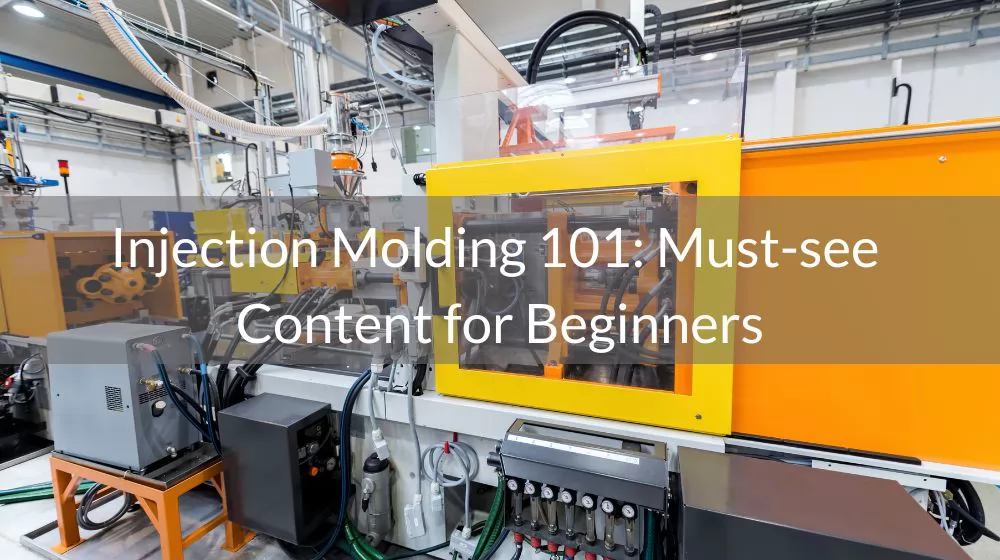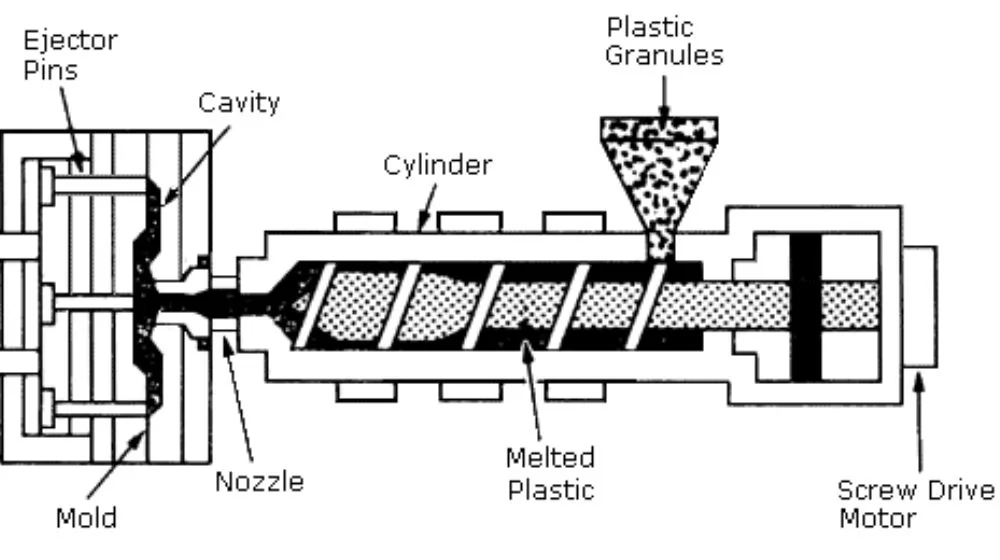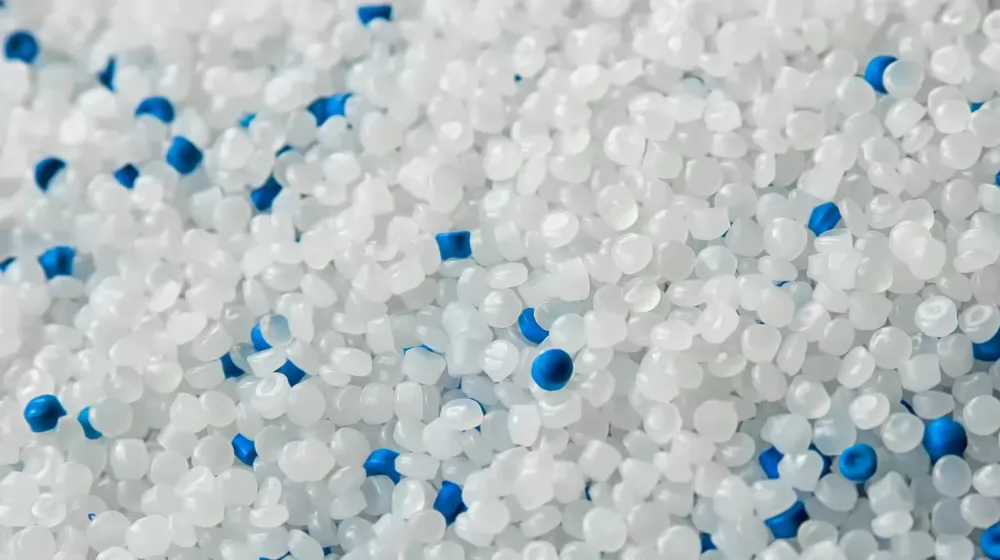
In today's world, where precision, efficiency and versatility are paramount in the manufacturing process, injection molding has become a game-changing technology. From everyday consumer goods to complex industrial components, injection molding plays a pivotal role in shaping our modern world. This revolutionary manufacturing method allows complex and durable plastic parts to be produced with astonishing consistency and speed.In this article, we delve into the fascinating field of injection molding, exploring its fundamentals, the steps involved, and its applications in various industries. Whether you are a curious hobbyist, budding engineer, or someone who wants to gain insight into this transformative process, this comprehensive guide aims to illuminate key aspects of injection molding, revealing its complexities and demonstrating its enormous potential.
Article Airectory:
What is injection molding?

Injection molding is a common method of plastics processing by injecting molten plastic material into a mold under high pressure, cooling and solidifying to form the desired part or product.
What are the principles of injection molding?
The principle of injection molding is to use an injection molding machine to inject molten plastic material into a mold, where it cools and solidifies, and finally forms the desired part or product. The following are the basic principles of injection molding:
Heating and Melting
Inside the injection molding machine is a heating cartridge that contains electric heating elements. Plastic granules or powder are put into the hopper of the injection molding machine, and the plastic is heated to a high enough temperature by the heating element in the heating barrel to melt it into a plastic molten state.
Injection and Filling
There is a screw inside the injection molding machine, which pushes the plastic forward through the rotation of the motor. The screw pushes the molten plastic from the hopper to the front end of the heating barrel, and the molten plastic is injected into the mold connected to the injection molding machine by pressure. The pressure and speed of the injection molding machine can be adjusted according to product requirements to achieve accurate injection.
Cooling and Solidification
Once the plastic is injected into the mold, the inside of the mold contains a cooling system, such as cooling water or other cooling media. The cooling system will quickly take away the heat from the surface of the mold, making the plastic gradually cool and solidify. The cooling time of the plastic in the mold depends on the type and thickness of the plastic.
Mold opening and Demoulding
When the plastic is completely cooled and solidified, the mold of the injection molding machine is opened. This can be achieved by means of a separation mechanism or an ejection device of the mould. Once the mold is opened, the finished product can be removed from the mold. Care is required when demolding to avoid damaging the finished product.
Injection molding: How do they work?
Do you want to know how the injection molding machine works? The following video will help you understand the working principle of the injection molding machine faster.
Which materials are suitable for injection molding?

Polyethylene (PE)
Polyethylene is one of the most commonly used plastics in daily life. It is widely used in the manufacture of plastic bags, films, barrels and other products. It is also the most important type of plastic waste on the planet.
Polypropylene (PP)
Polypropylene is a semi-crystalline thermoplastic. It has high impact resistance, strong mechanical properties, and resistance to various organic solvents and acid and alkali corrosion. Wide range of applications in industry, including packaging materials and labels, textiles (e.g., rope, thermal underwear and carpets), stationery, plastic parts and various types of reusable containers, thermoplastic polymer equipment used in laboratories , Speakers, auto parts, and polymer banknotes are one of the most common polymer materials.
Polyvinyl chloride (PVC)
Polyvinyl chloride is a polymer material obtained by addition polymerization of vinyl chloride. It is the third most widely produced synthetic plastic polymer after polyethylene and polypropylene.PVC comes in two basic forms: rigid and flexible. Rigid form PVC material can be used in pipes, doors and windows, it can also be used in bottles, other non-food packaging, and bank or membership cards. It can also be made into soft finishes, made more flexible by adding plasticizers, most commonly phthalates. In this form, it can be used in flexible conduit, cable insulation, imitation leather, soft signage, inflatable products, and replaces rubber in many applications.
What are the advantages and disadvantages of injection molding?
Advantage
(1) High production efficiency: Injection molding can realize high-speed continuous production and is suitable for large-scale production needs. The injection molding machine can complete the injection molding process in a short time, which improves the production efficiency.
(2) High precision: Injection molding can produce parts and products with complex shapes and precise dimensions. The injection molding machine has a high-precision control system, which can ensure the consistency and accuracy of the product.
(3) Design flexibility: Injection molding can be flexibly adjusted according to product design requirements, and products of various shapes, sizes and complex structures can be manufactured. Injection molding is suitable for diverse product designs and innovations.
(4) Wide range of materials: Injection molding can be processed with various plastic materials, including polyethylene, polypropylene, polyvinyl chloride, etc. According to the needs of the product, materials with different properties and characteristics can be selected.
(5) Economy: Injection molding has a relatively low cost, especially in mass production. Injection molding can realize automatic production, reduce labor costs, and have less waste of materials.
Shortcoming
(1) High initial investment: The purchase and setup of injection molding equipment requires a high initial investment. Especially for small-scale production enterprises, purchasing an injection molding machine can be a burden.
(2) Design limitations: Since injection molds are required in the injection molding process, product design is limited by mold structure and material fluidity. Complex product designs may require complex injection molds, adding to the complexity and cost of design and manufacturing.
(3) Environmental impact: The plastic materials used in the injection molding process are usually petrochemical products, which cause certain pollution to the environment. In addition, discarded plastic products also put pressure on the environment, because plastic is difficult to degrade.
(4) Long preparation time: Injection molding needs to manufacture injection molds, which involves steps such as mold design, manufacture and debugging. This can take a long time, especially for complex product designs.
Common prices for injection molding
Injection molding is widely used today in consumer goods and engineering applications. Almost all plastic items around you are manufactured using injection molding. That's because the technology can produce identical parts in high volumes (typically 1,000 to over 100,000 pieces) at a very low cost-per-piece (typically $1-5 each).
But compared to other technologies, injection molding has relatively high start-up costs, mainly because of the need for custom molds. A tooling can cost anywhere from $3,000 to over $100,000, depending on its complexity, material (aluminum or steel), and precision (prototype, trial run, or full production tooling).
What are the applications of injection molding?
Auto Parts: Injection molding is widely used in the automotive industry. It can be used to make body shells, dashboards, door panels, seats and other components. Injection molding materials are lightweight, durable, and design flexible to meet various requirements in automotive manufacturing.
Electronic products: Injection molding is commonly used in the production of housings, connectors, switches and other parts of electronic products. It can provide good insulation performance and mechanical protection, and also meet the needs of electronic product design.
Medical Devices: Injection molding plays an important role in the medical industry. Many medical devices and medical supplies, such as syringes, infusion sets, surgical instruments, etc., can be produced by injection molding. Medical-grade plastic materials have good biocompatibility and chemical resistance, and can meet the stringent requirements for materials in the medical field.
Household appliances: Many household appliances, such as washing machines, refrigerators, rice cookers, etc., use injection molding to manufacture their casings and accessories. Injection molding can provide the insulation performance, durability and design freedom of electrical enclosures, while also meeting the mass production needs in electrical appliance manufacturing.
Packaging industry: Injection molding is widely used in the packaging industry. Plastic bottles, plastic containers, plastic boxes, etc. can all be produced by injection molding. Injection molding materials have excellent transparency, toughness and sealing performance, which can meet the needs of different types of packaging.
These are just some of the applications of injection molding, in fact injection molding is widely used in many other fields such as aerospace, construction, toys, etc. Advantages of injection molding include cost-effectiveness, short production cycle times, and design flexibility, making it an important manufacturing process.
Why is injection molding important in manufacturing?
Injection molding is an efficient manufacturing process that can produce large quantities of products quickly. Injection molding machines are capable of continuous production with short cycle times, so that a large number of products can be efficiently manufactured in a short period of time, thereby increasing production efficiency.
Low cost
Injection molding technology can often realize automated production, reduce manual labor, and reduce labor costs. In addition, injection molding can use inexpensive materials such as plastics, making it less costly than other manufacturing processes.
Make complex shapes
Injection molding can produce products with complex shapes and details, including internal cavities, small structures and precision parts. With well-designed molds, multiple components can be manufactured in one mold, which significantly simplifies the production process.
Variety of material choices
Injection molding can use various types of plastic materials such as polyethylene, polypropylene and polyvinyl chloride. These materials have different characteristics, and the appropriate material can be selected according to product requirements. In addition, material properties can be altered by adding fillers, plasticizers and other additives.
Stable product quality
Injection molding allows for highly precise control of the process, ensuring consistent product dimensions and consistent quality. Injection molding machines feature excellent repeatability and controllability to minimize human error and improve product quality and consistency.
Sustainable development
Plastic raw materials used in injection molding can be recycled, promoting the sustainable use of resources. In addition, injection molding can reduce environmental impact by optimizing design and reducing waste.
When should I use injection molding?
Injection molding is an efficient option when you need to produce large quantities of the same or similar products. Injection molding machines can produce large batches of products in rapid succession, improving production efficiency.
When your products require complex shapes or details, injection molding is suitable for manufacturing products with complex shapes, fine structures and precision parts. Through reasonable mold design, injection molding can complete the manufacture of multiple parts at one time, reducing production processes and manual operations.
Injection molding has relatively low production costs when you need to control production costs. It can use cheap plastic materials, while the automated production process reduces labor costs. Injection molding is an option worth considering if you want cost-effective results.
When the product requires high quality and consistency, a high degree of precise control can be achieved during the injection molding process to ensure product size consistency and quality stability. If you need high-quality and consistent products, injection molding can meet your needs.
Or if you are concerned about sustainable development, the plastic materials used in the injection molding process can be recycled and reused, which is conducive to the sustainable use of resources. Injection molding is an environmentally friendly choice if you care about sustainability and want to reduce your environmental impact.
What is the difference between injection molding and 3d printing?
Injection molding and 3D printing are two different manufacturing technologies, and there are some differences in their working principles, scope of application and application fields.
Working principle
Injection Molding: Injection molding is done by injecting heated molten plastic material into a mold and then cooling to solidify into the desired shape. The process involves steps such as melting, injection, cooling and demoulding of the plastic.
3D printing: 3D printing is a process of layer-by-layer construction. It uses a computer-controlled printer to process layers of added material, such as plastic, metal, or other materials, into the desired shape.
Manufacturing method
Injection Molding: Injection molding is usually a way of mass production. It uses specialized injection molding machines and molds to continuously produce the same or similar products.
3D Printing: 3D printing enables rapid prototyping and low-volume production. Each print can produce different shapes and designs, with greater flexibility.
Scope of application
Injection molding: Injection molding is suitable for producing high-volume products, especially those that require a high degree of consistency and precision. It is widely used in automobiles, electronics, medical equipment, household products and other fields.
3D printing: 3D printing is suitable for rapid prototyping, personalized customization and small batch production. It has a wide range of applications in design, education, medical care, art and other fields.
Material selection
Injection molding: Injection molding mainly uses plastic materials such as polypropylene, polyethylene, polyvinyl chloride, etc. Different plastic materials have different properties and properties.
3D printing: 3D printing can use a variety of materials, including plastics, metals, and more. Suitable materials can be selected according to needs.
How to choose a reliable injection molding company?

1. Assess the company's experience and expertise: Review the company's background and history to understand its experience and expertise in the field of injection molding. Preference is given to companies with rich experience and technical strength, they are more likely to provide high-quality products and professional services.
2. View samples and cases: Ask injection molding companies to provide past product samples or cases to evaluate their process and product quality. Evaluate the company's injection molding capabilities by observing the appearance, dimensional accuracy and surface quality of the samples.
3. Understand customer feedback and word of mouth: Look for customer feedback about the company. Information may be obtained through online reviews, customer testimonials, or direct communication with other customers. Positive customer feedback and good reputation are important references for choosing a reliable company.
Conclusion
Injection molding as an important manufacturing process plays a huge role in various industries. Through injection molding, we can efficiently and cost-effectively produce high-volume products, realize the manufacture of complex shapes and details, ensure the quality and consistency of products, and contribute to sustainable development.
With the continuous development of science and technology, injection molding technology is also constantly improving. The application of new materials, the innovation of mold design and the advancement of automated production have brought more possibilities and development opportunities for injection molding. In the future, we can look forward to the further application of injection molding in the manufacturing industry, bringing us more high-quality, high-performance products.
Through this popular science article, we hope to increase people's understanding of injection molding and let everyone have a deeper understanding of this manufacturing process. The advantages of injection molding are its high efficiency, low cost, flexibility and quality consistency, which make it an indispensable part of the manufacturing industry. Whether it is producing auto parts, home appliances or medical devices, injection molding plays an important role in creating a better life for us.



